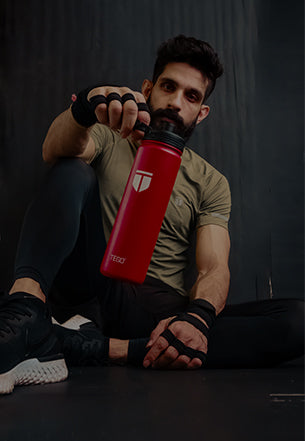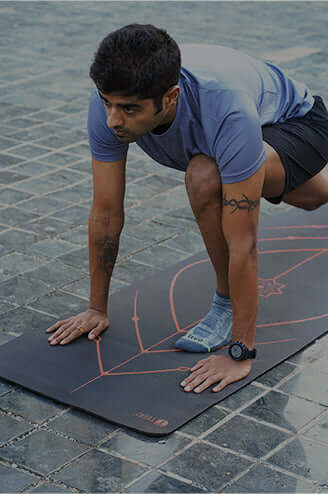Nihad Panju knows the importance of setting goals. The Mumbai-based marathoner and obstacle runner has a string of some serious runs to his name, including the Tata Mumbai Marathon 10K in 2019, the Standard Chartered Mumbai Half Marathon 2016 and its Singapore counterpart in 2017. But, it’s undeniably his belief that “no goal is out of reach” that really matters. From a diagnosis that left him with a partial paralysis to going against all odds and returning to a high level of independence right up to becoming a marathoner, Nihad knows that grit and perseverance does indeed pay off. He was just five months old when the diagnosis of Tubercular Meningitis left him with Hemiplegia, or partial paralysis on the left side of his body.
Growing up, despite trying everything from Ayurveda massages to physiotherapy, nothing seemed to make the slightest difference. “I would fall multiple times a day, my balance was horrible, and my left hand was tightly stuck to my chest,” he tells us. Then, when he was ten, his parents came across the Philadelphia-based Institutes for the Achievement of Human Potential (IAHP) and its neurologic reorganization programme — a physically and mentally grueling programme designed to train the brain using physical techniques like creeping (moving one’s body forward with the abdomen touching the floor), crawling (moving one’s body forward with a raised abdomen) and masking (breathing into a mask to increase oxygen levels in the brain). “Over the four years of the programme which I practiced in Mumbai, I’d crawl for two and a half miles a day, creep a mile and a half, and do masking between 60-80 times a day for around 30-60 seconds. My days lasted 12-14 hours. It was an intense programme and I can now safely say that training for a marathon is a walk in the park in comparison,” says Nihad, who was homeschooled by his mother at the time.
Within the first two and a half weeks, his left hand opened up. “It was literally for a few seconds, but it was a big deal. It was the little things at that point,” he remembers. Four and a half years into the programme, there were noticeable improvements, and he felt ready to be reintegrated into ‘normal life’ as a teenager. In 2005, after graduating the programme, he completed his IGCSE, moved to Singapore on his own for a three-year course in interactive multimedia design, and signed up at a gym.
His love for running would begin a few years later, back in Mumbai. “Initially, my trainer, one of my closest friends now, treated me with kid gloves. We’d train at the gym and do bootcamps at the Cricket Club of India (CCI). I had always heard him tell the others that their life would change if they ran a 21k. I always heard this from the periphery and wondered why he never told me the same thing. One day, I went up to him and told him that I wanted to run the 21k. He asked me to start with three rounds at the CCI which is 1.2 kms — nothing compared to 21 km. A hundred metres into the run, I began to wonder what I had gotten myself into. But I pushed it and completed the three rounds, gradually building it up to 14 rounds, then 16. Eventually, I joined the same group for their early morning road runs. I was much slower than them, but I’d bump up the distances every week. It was 10 km in one week, 12 km in the next and then went up to 16 km, 18 km and 19.6 kms which is the maximum I had reached.
Nihad, now 31, continues to train through the year — whether he’s preparing for a marathon or not. Even the continual lockdowns didn’t stop him. His last two marathons were virtual. Like other participants in the Delhi-based obstacle running series Devil’s Circuit which went digital in 2020, he too ran the distance and tracked and uploaded his data online. Most recently, he made it to both the India and Asia Book of Records for the maximum half marathons completed by a person with Hemiplegia. Fittingly, he works with an Indian start-up that’s developing an AI-driven physiotherapy app called Radian Mobility. We had a chat with the unstoppable Nihad about how he beat the odds on his journey to become a marathoner.

What is it that keeps you motivated?
I strive to stay fit and improve my fitness level. And, of course, the goal (what I’m training for) is the biggest driver and motivation.
The most challenging part of your journey to become a marathoner?
Back when I was training for my first 21k, we were running one long-distance run a week. We started with 5k, built it up to 20k or 21k and then gradually brought it back down to 5k, with a few days of rest before race day. The most challenging part was reaching my first 10k in training, and then it was smooth sailing.
The most challenging marathon or obstacle course you’ve participated in?
The most challenging marathon I have run was in Pune in December 2013. The route had really bad roads, so it needed all the focus possible. Plus, we were running with traffic as the roads weren’t blocked. I take it as a win though, it was challenging but I still finished.
What’s your daily training regime like?
Pre-Covid times, I’d do 2-3 workouts at the gym, 2-3 bootcamp sessions and one long-distance run every week (sometimes more than depending on recovery and injuries). Post-Covid, it was home workouts, HIIT sessions and a walk/run whenever it permitted. I recently started running without a mask after two years, and I feel like I was flying again.
What does your diet consist of leading up to a marathon?
Meals before a long run and especially before a race is high carb. If I’m running tomorrow, I’ll eat a high-carb meal the night before. Otherwise, I follow a balanced diet with a few cheat meals here and there.
At TEGO, we are in constant pursuit of finding ways to evolve and be better than yesterday. How do you keep yourself on the path to constantly improving and evolving?
The one thing I can safely say that drives and keeps me motivated are my goals, whatever they may be — a marathon, Devil’s Circuit or just a regular workout because even though you may not realise it, you’re constantly stepping up your game and doing better than yesterday.
A word of advice to the TEGO community of fitness enthusiasts and professionals?
Keep at it even on your bad days and always keep whatever goals you’re working towards in mind to really drive you. It always pays off. Initially, people would tell me to have realistic goals and that 21k was crazy. I turned those inputs of pessimism into motivation. Don’t let people tell you that you can’t do something. If you want to achieve something, go out there and do it.







